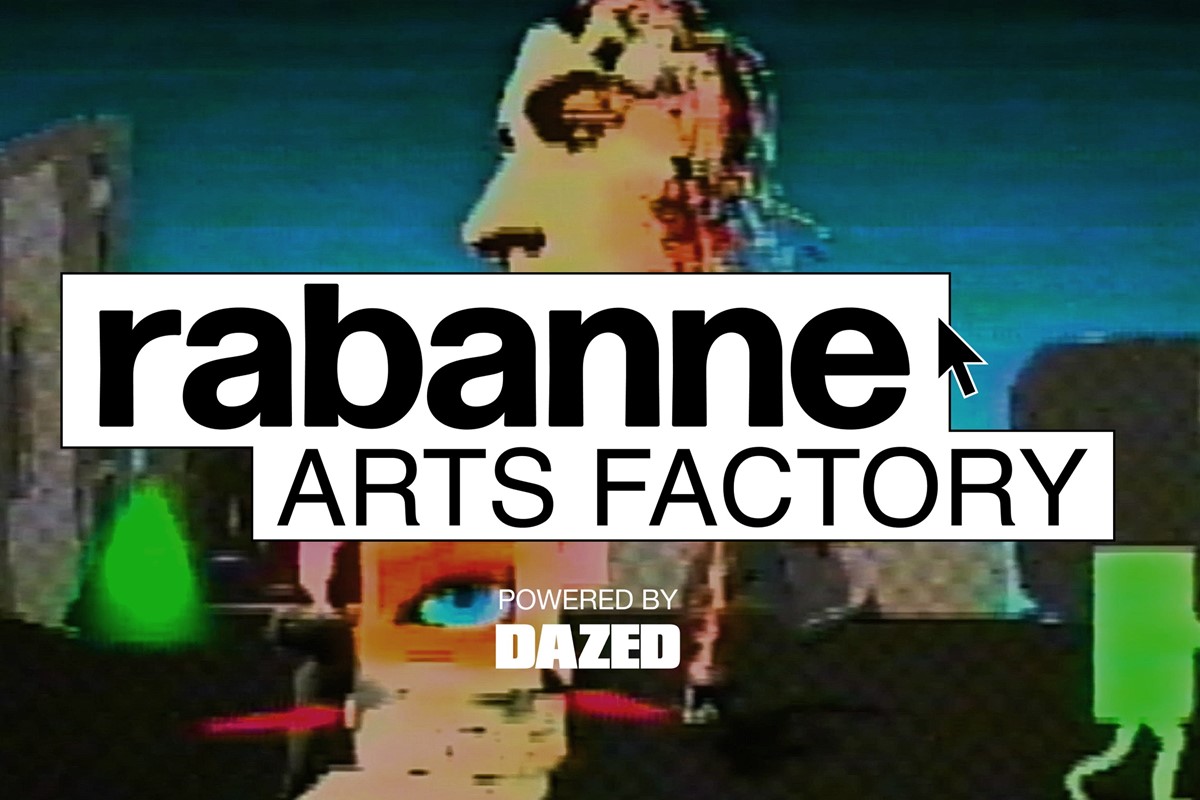
Rewrite
An art star is born! Lucy Ellis has been announced as the winner of the inaugural Rabanne Arts Factory prize. As you’ll remember, throughout the year, The Rabanne Arts Factory initiative has been searching for the next generation of digital image-making visionaries. Having whittled thousands of entries to just six, all of whom explored different forms of multimedia, merging traditional and digital practices to push the boundaries of contemporary art. An esteemed panel, including Jefferson Hack, Julien Dossena, Venus Lau, and Claude Adjil, deliberated to finally select Ellis as the inaugural winner.
Ellis, an experimental animator has recently graduated with a BA in Fine Art and Creative Computing and has been honing a practice defined by a deep understanding of texture, materiality, and process, which sees her transform everyday objects – often scrap and found materials – into powerful storytelling tools.
Ellis has been awarded a financial reward to support her progression as an artist and will see her work shown at Art Basel Miami in December. When asked about her plans for the prize money, Ellis revealed she intends to use the funds to expand her practice. “I’m planning on investing in some new equipment, particularly a VHS player and a new computer, to create more work. I’d also like to invest in a studio space where I can solder wires together and have more freedom to create!” Ellis is also researching the history of digital art, particularly in relation to motion graphics, which will inform a new film she hopes to exhibit in December at Art Basel Miami.
For her submission to The Rabanne Arts Factory, Ellis was deeply inspired by Rabanne’s design ethos when creating her final work for the competition. “I was inspired by Rabanne’s perfume bottle designs – they reminded me of artefacts, something to be treasured. This idea is also reflected in Rabanne’s futuristic dress designs,” she explained. “I started reflecting on the bodies that digital material is stored in, like old monitors and peripherals. They represent both technological development and waste products of obsolescence as tech advances and leaves them behind. This made me think about the physical proximity of our devices to our bodies.”
This culminated in an exploration of ‘technophilia’ and looking at how our devices mirror romantic relationships. Ellis’ lo-fi animation featured characters with ambiguous interactions with their devices – are they being controlled by the device? Are they behaving mutually? The piece was created by collaging imagery, digitally generated images, and layered digital textures. Ellis then transferred this to a VHS tape before rendering it digitally to add more texture and details.
Ellis’ skill for repurposing discarded materials as a comment on the relationship between technology and the human body cemented the decision to award her the prize. Julien Dossena said: “We all agreed that the original universe of Lucy Ellis, already so complete, was the right one to be the winner. Lucy has the ability to make us dream by creating a very complete world. Her work is very referenced yet transcribed into a unique world that really inspires me.”
Jefferson Hack was struck by her critique of the digital age. “I liked that Lucy’s work is a playful use of new and obsolete digital technologies that talks about the dark side of our relationship to the media,” he said. “Her late 20th-century video game aesthetics, mixed with recent pop culture and the history of art, shows great skill and craftsmanship as well as a clear critique of the post-digital age we are in. I’m excited to see how her career grows as the inaugural winner of the prize.”
Venus Lau highlighted Ellis’ playful yet thought-provoking use of media. “This was an exciting process to see the fresh talents; among the surprises is Lucy’s playful stitching of various media in her art, which revives some of the ‘zombie media’ that subside in the waves of planned obsolescence and the thirst for endless ‘newness’ in the technosphere we live in.”
Claude Adjil was also impressed by her innovative approach to digital art. “Lucy has created an impressive and original fusion of animation with early video art, constructing a unique world of her own. Her ability to weave narrative and storytelling through this creative intersection is a testament to her talent and vision.”
Winning the Rabanne Arts Factory prize not only provides Ellis with financial support and industry recognition but also the opportunity to collaborate with Rabanne on an exciting project at the end of the year. Additionally, the opportunity to showcase her work at Art Basel Miami Beach, one of the most prestigious art events in the world, will only see her star rise higher.
in HTML format, including tags, to make it appealing and easy to read for Japanese-speaking readers aged 20 to 40 interested in fashion. Organize the content with appropriate headings and subheadings (h1, h2, h3, h4, h5, h6), translating all text, including headings, into Japanese. Retain any existing
tags from
An art star is born! Lucy Ellis has been announced as the winner of the inaugural Rabanne Arts Factory prize. As you’ll remember, throughout the year, The Rabanne Arts Factory initiative has been searching for the next generation of digital image-making visionaries. Having whittled thousands of entries to just six, all of whom explored different forms of multimedia, merging traditional and digital practices to push the boundaries of contemporary art. An esteemed panel, including Jefferson Hack, Julien Dossena, Venus Lau, and Claude Adjil, deliberated to finally select Ellis as the inaugural winner.
Ellis, an experimental animator has recently graduated with a BA in Fine Art and Creative Computing and has been honing a practice defined by a deep understanding of texture, materiality, and process, which sees her transform everyday objects – often scrap and found materials – into powerful storytelling tools.
Ellis has been awarded a financial reward to support her progression as an artist and will see her work shown at Art Basel Miami in December. When asked about her plans for the prize money, Ellis revealed she intends to use the funds to expand her practice. “I’m planning on investing in some new equipment, particularly a VHS player and a new computer, to create more work. I’d also like to invest in a studio space where I can solder wires together and have more freedom to create!” Ellis is also researching the history of digital art, particularly in relation to motion graphics, which will inform a new film she hopes to exhibit in December at Art Basel Miami.
For her submission to The Rabanne Arts Factory, Ellis was deeply inspired by Rabanne’s design ethos when creating her final work for the competition. “I was inspired by Rabanne’s perfume bottle designs – they reminded me of artefacts, something to be treasured. This idea is also reflected in Rabanne’s futuristic dress designs,” she explained. “I started reflecting on the bodies that digital material is stored in, like old monitors and peripherals. They represent both technological development and waste products of obsolescence as tech advances and leaves them behind. This made me think about the physical proximity of our devices to our bodies.”
This culminated in an exploration of ‘technophilia’ and looking at how our devices mirror romantic relationships. Ellis’ lo-fi animation featured characters with ambiguous interactions with their devices – are they being controlled by the device? Are they behaving mutually? The piece was created by collaging imagery, digitally generated images, and layered digital textures. Ellis then transferred this to a VHS tape before rendering it digitally to add more texture and details.
Ellis’ skill for repurposing discarded materials as a comment on the relationship between technology and the human body cemented the decision to award her the prize. Julien Dossena said: “We all agreed that the original universe of Lucy Ellis, already so complete, was the right one to be the winner. Lucy has the ability to make us dream by creating a very complete world. Her work is very referenced yet transcribed into a unique world that really inspires me.”
Jefferson Hack was struck by her critique of the digital age. “I liked that Lucy’s work is a playful use of new and obsolete digital technologies that talks about the dark side of our relationship to the media,” he said. “Her late 20th-century video game aesthetics, mixed with recent pop culture and the history of art, shows great skill and craftsmanship as well as a clear critique of the post-digital age we are in. I’m excited to see how her career grows as the inaugural winner of the prize.”
Venus Lau highlighted Ellis’ playful yet thought-provoking use of media. “This was an exciting process to see the fresh talents; among the surprises is Lucy’s playful stitching of various media in her art, which revives some of the ‘zombie media’ that subside in the waves of planned obsolescence and the thirst for endless ‘newness’ in the technosphere we live in.”
Claude Adjil was also impressed by her innovative approach to digital art. “Lucy has created an impressive and original fusion of animation with early video art, constructing a unique world of her own. Her ability to weave narrative and storytelling through this creative intersection is a testament to her talent and vision.”
Winning the Rabanne Arts Factory prize not only provides Ellis with financial support and industry recognition but also the opportunity to collaborate with Rabanne on an exciting project at the end of the year. Additionally, the opportunity to showcase her work at Art Basel Miami Beach, one of the most prestigious art events in the world, will only see her star rise higher.
and integrate them seamlessly into the new content without adding new tags. Ensure the new content is fashion-related, written entirely in Japanese, and approximately 1500 words. Conclude with a “結論” section and a well-formatted “よくある質問” section. Avoid including an introduction or a note explaining the process.


